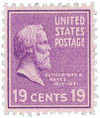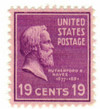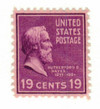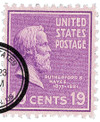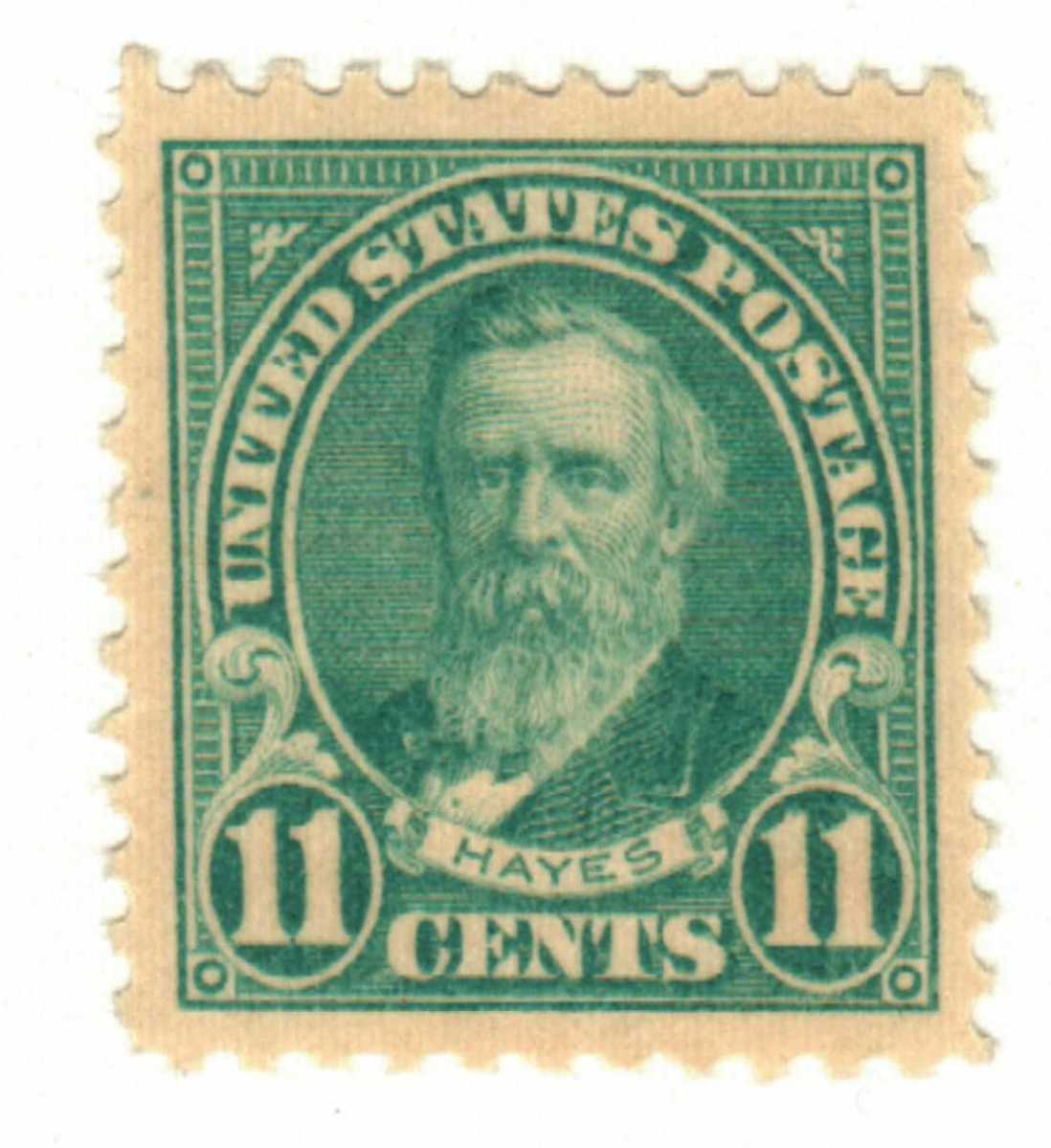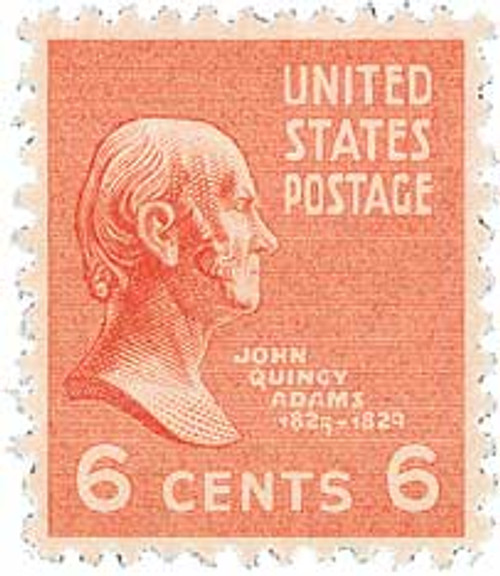
# 824 - 1938 19c Hayes, purple
19¢ Hayes
1938 Presidential Series
City: Washington, DC
Quantity: 106,662,900
Printed by: Bureau of Engraving and Printing
Printing Method: Rotary press
Perforations: 11 x 10 ½
Color: Bright violet
Happy Birthday Rutherford Hayes
Hayes attended private schools in Ohio and Connecticut, and then went to Kenyon College, where he graduated first in his class in 1842. He studied law in Ohio for a year before entering Harvard Law School. After graduation, Hayes began practicing in Lower Sandusky, Ohio. In 1849 he moved to Cincinnati, where he became a successful defense lawyer and gained a reputation for defending fugitive slaves. It was here that Hayes married Lucy Ware Webb. She was a graduate of Cincinnati’s Wesleyan Women’s College, making Lucy Hayes the first President’s wife to graduate from college.
Hayes was almost forty years old and the father of three children when the Civil War began with the attack on Fort Sumter. He convinced members of his Literary Club to volunteer with him, and he was appointed to the rank of major in the 23rd Ohio Volunteer Infantry. Though Hayes had no military experience, he became a respected leader. He was wounded many times and his wife, Lucy, a nurse, went to the battlefield to care for the Major. She became known as “Mother Lucy,” because of her care for Hayes’ fellow soldiers. Hayes was eventually promoted to the rank of brevet major general.
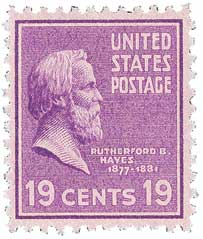
While fighting the Civil War, Hayes was nominated for the U.S. House of Representatives. Though he refused to leave his post to campaign, Hayes was elected and took his seat in Congress in December 1865. While in Congress, he supported Reconstruction of the South and was Chairman of the Committee on the Library of Congress. Hayes tried to secure funds to expand the Library’s collection.
Hayes resigned from Congress when he was nominated for governor of Ohio. He was elected to two terms. While Hayes was governor, Ohio ratified the 15th amendment to the U.S. Constitution, which gave voter rights to former slaves. The Ohio State University was also founded. In 1872, Hayes tried unsuccessfully to run for Congress. He retired to his uncle’s estate, Spiegel Grove. Hayes’ retirement didn’t last long, for he ran for governor in 1875 and was elected again. He became the first man in Ohio’s history to win a third term as governor.
At the 1876 Republican National Convention, the party’s first choice nominee was found to be corrupt. After seven rounds of voting, Hayes was selected as the nominee. In the national election, Hayes’ opponent Samuel J. Tilden won the popular vote. But the Republicans questioned the results in several states. When no consensus could be reached, Congress set up a special commission in January of 1877. The Republicans held a small majority on the commission so all the disputed electoral votes went to Hayes. He was declared President less than three days before the inauguration was scheduled to take place.
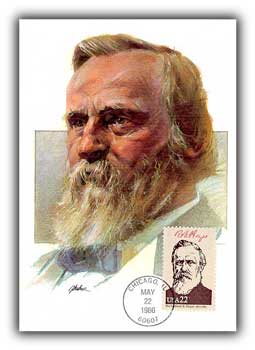
The Compromise of 1877 was an unwritten deal that helped decide the results of the election. In exchange for the presidency, the Republicans agreed to some Democratic concessions. A key stipulation was the withdrawal of federal troops from the South. Hayes accomplished this within a month of taking office. Republican lawmakers left the South after the troops were removed from protecting state offices.
The Compromise of 1877 allowed Congress to vote on the Congressional Committee’s recommendation to elect Hayes as President without a filibuster that had been threatened by some Democrats. It didn’t accomplish much more than that. Many African-Americans referred to it as “The Great Betrayal” because they lost the protection of the federal troops, and they were denied their voting rights for many years.
The Democrats were outraged at the results and called Hayes “Rutherfraud.” Because of safety concerns, he secretly took his oath of office on March 3, 1877 in the Red Room of the White House. His public inauguration was two days later, and because of threats to Hayes’ life, the first “secret service” was used; agents surrounded his carriage as he made his way to the ceremony.
Hayes wanted to return the United States to financial stability. Still recovering from the Civil War, many farmers and Congressmen wanted to start minting silver coins to relieve debt. President Hayes advocated a return to the gold standard. By the spring of 1879, all Civil War bonds had been paid.
The United States had grown to be a country with two important coasts. To ship goods from one coast to the other was time consuming and dangerous because boats had to travel around South America. A canal through Central America would greatly shorten the trip. When the Suez Canal was completed in 1869, talk of a Panama Canal increased. President Hayes refused to have the government fund the building of the waterway but he saw its necessity. He said a canal would become “virtually a part of the coast line of the United States.” The project went bankrupt in 1889, and progress was halted for many years. The Canal wasn’t completed until 1914.
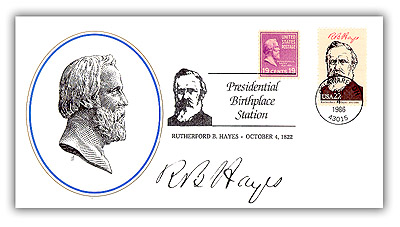
The Transcontinental Railroad was being built on both sides of the United States, and workers were needed. Chinese immigrants were willing to work under the grueling conditions of railroad construction, so they were welcomed to the U.S. The Burlingame Treaty of 1868 established friendly relations with China. Part of the agreement protected the immigrants from persecution. Their ability to work hard and their willingness to accept low wages led to anti-Chinese sentiment, especially in the West. This led to a bill that would allow no more than 15 Chinese passengers on each incoming boat. Hayes vetoed this bill because it went against the Burlingame Treaty.
After serving only one term, as he had promised, Rutherford Hayes retired to his home, Spiegel Grove, in Fremont, Ohio. He spent his time trying to improve veteran’s organizations and conditions for prisoners. Hayes became the first president of the National Prison Reform Association. The former President felt education was the best way to heal the Union and allow individuals to improve themselves. He was a Trustee of the Peabody Fund and the first president of the Slater Fund, both dedicated to the education of underprivileged children in the South. He gave a scholarship to W.E.B. DuBois, who became a leader in the National Association for the Advancement of Colored People (NAACP). Hayes advocated federal subsidies for education of all children.
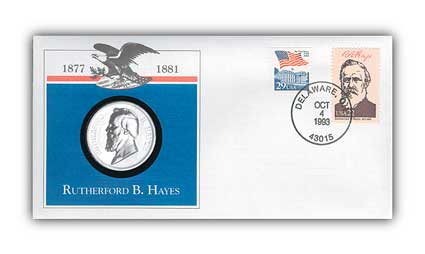
Hayes was bothered by the vast difference between the wealthy and the poor. He was troubled that property was “largely in a few hands and large masses of people are unable to earn homes, education, and a support in old age.” He favored laws that would regulate corporations and taxation.
Four years after his beloved wife Lucy died, Hayes became ill in Cleveland. He returned to his estate and died on January 17, 1893. His last words were, “I know that I’m going where Lucy is.”
19¢ Hayes
1938 Presidential Series
City: Washington, DC
Quantity: 106,662,900
Printed by: Bureau of Engraving and Printing
Printing Method: Rotary press
Perforations: 11 x 10 ½
Color: Bright violet
Happy Birthday Rutherford Hayes
Hayes attended private schools in Ohio and Connecticut, and then went to Kenyon College, where he graduated first in his class in 1842. He studied law in Ohio for a year before entering Harvard Law School. After graduation, Hayes began practicing in Lower Sandusky, Ohio. In 1849 he moved to Cincinnati, where he became a successful defense lawyer and gained a reputation for defending fugitive slaves. It was here that Hayes married Lucy Ware Webb. She was a graduate of Cincinnati’s Wesleyan Women’s College, making Lucy Hayes the first President’s wife to graduate from college.
Hayes was almost forty years old and the father of three children when the Civil War began with the attack on Fort Sumter. He convinced members of his Literary Club to volunteer with him, and he was appointed to the rank of major in the 23rd Ohio Volunteer Infantry. Though Hayes had no military experience, he became a respected leader. He was wounded many times and his wife, Lucy, a nurse, went to the battlefield to care for the Major. She became known as “Mother Lucy,” because of her care for Hayes’ fellow soldiers. Hayes was eventually promoted to the rank of brevet major general.

While fighting the Civil War, Hayes was nominated for the U.S. House of Representatives. Though he refused to leave his post to campaign, Hayes was elected and took his seat in Congress in December 1865. While in Congress, he supported Reconstruction of the South and was Chairman of the Committee on the Library of Congress. Hayes tried to secure funds to expand the Library’s collection.
Hayes resigned from Congress when he was nominated for governor of Ohio. He was elected to two terms. While Hayes was governor, Ohio ratified the 15th amendment to the U.S. Constitution, which gave voter rights to former slaves. The Ohio State University was also founded. In 1872, Hayes tried unsuccessfully to run for Congress. He retired to his uncle’s estate, Spiegel Grove. Hayes’ retirement didn’t last long, for he ran for governor in 1875 and was elected again. He became the first man in Ohio’s history to win a third term as governor.
At the 1876 Republican National Convention, the party’s first choice nominee was found to be corrupt. After seven rounds of voting, Hayes was selected as the nominee. In the national election, Hayes’ opponent Samuel J. Tilden won the popular vote. But the Republicans questioned the results in several states. When no consensus could be reached, Congress set up a special commission in January of 1877. The Republicans held a small majority on the commission so all the disputed electoral votes went to Hayes. He was declared President less than three days before the inauguration was scheduled to take place.

The Compromise of 1877 was an unwritten deal that helped decide the results of the election. In exchange for the presidency, the Republicans agreed to some Democratic concessions. A key stipulation was the withdrawal of federal troops from the South. Hayes accomplished this within a month of taking office. Republican lawmakers left the South after the troops were removed from protecting state offices.
The Compromise of 1877 allowed Congress to vote on the Congressional Committee’s recommendation to elect Hayes as President without a filibuster that had been threatened by some Democrats. It didn’t accomplish much more than that. Many African-Americans referred to it as “The Great Betrayal” because they lost the protection of the federal troops, and they were denied their voting rights for many years.
The Democrats were outraged at the results and called Hayes “Rutherfraud.” Because of safety concerns, he secretly took his oath of office on March 3, 1877 in the Red Room of the White House. His public inauguration was two days later, and because of threats to Hayes’ life, the first “secret service” was used; agents surrounded his carriage as he made his way to the ceremony.
Hayes wanted to return the United States to financial stability. Still recovering from the Civil War, many farmers and Congressmen wanted to start minting silver coins to relieve debt. President Hayes advocated a return to the gold standard. By the spring of 1879, all Civil War bonds had been paid.
The United States had grown to be a country with two important coasts. To ship goods from one coast to the other was time consuming and dangerous because boats had to travel around South America. A canal through Central America would greatly shorten the trip. When the Suez Canal was completed in 1869, talk of a Panama Canal increased. President Hayes refused to have the government fund the building of the waterway but he saw its necessity. He said a canal would become “virtually a part of the coast line of the United States.” The project went bankrupt in 1889, and progress was halted for many years. The Canal wasn’t completed until 1914.

The Transcontinental Railroad was being built on both sides of the United States, and workers were needed. Chinese immigrants were willing to work under the grueling conditions of railroad construction, so they were welcomed to the U.S. The Burlingame Treaty of 1868 established friendly relations with China. Part of the agreement protected the immigrants from persecution. Their ability to work hard and their willingness to accept low wages led to anti-Chinese sentiment, especially in the West. This led to a bill that would allow no more than 15 Chinese passengers on each incoming boat. Hayes vetoed this bill because it went against the Burlingame Treaty.
After serving only one term, as he had promised, Rutherford Hayes retired to his home, Spiegel Grove, in Fremont, Ohio. He spent his time trying to improve veteran’s organizations and conditions for prisoners. Hayes became the first president of the National Prison Reform Association. The former President felt education was the best way to heal the Union and allow individuals to improve themselves. He was a Trustee of the Peabody Fund and the first president of the Slater Fund, both dedicated to the education of underprivileged children in the South. He gave a scholarship to W.E.B. DuBois, who became a leader in the National Association for the Advancement of Colored People (NAACP). Hayes advocated federal subsidies for education of all children.

Hayes was bothered by the vast difference between the wealthy and the poor. He was troubled that property was “largely in a few hands and large masses of people are unable to earn homes, education, and a support in old age.” He favored laws that would regulate corporations and taxation.
Four years after his beloved wife Lucy died, Hayes became ill in Cleveland. He returned to his estate and died on January 17, 1893. His last words were, “I know that I’m going where Lucy is.”




